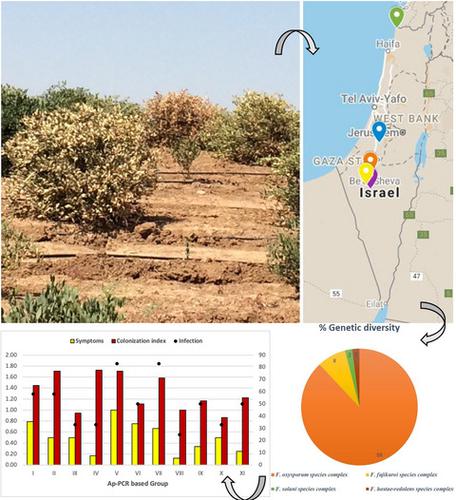当前位置:
X-MOL 学术
›
Plant Pathol.
›
论文详情
Our official English website, www.x-mol.net, welcomes your
feedback! (Note: you will need to create a separate account there.)
Characterization of Fusarium population associated with wilt of jojoba in Israel
Plant Pathology ( IF 2.3 ) Pub Date : 2021-01-22 , DOI: 10.1111/ppa.13345 Marcel Maymon 1 , Gunjan Sharma 1 , Marina Hazanovsky 2 , Orly Erlich 2 , Shir Pessach 1 , Stanley Freeman 1 , Leah Tsror 2
Plant Pathology ( IF 2.3 ) Pub Date : 2021-01-22 , DOI: 10.1111/ppa.13345 Marcel Maymon 1 , Gunjan Sharma 1 , Marina Hazanovsky 2 , Orly Erlich 2 , Shir Pessach 1 , Stanley Freeman 1 , Leah Tsror 2
Affiliation

|
Fusarium wilt, caused by Fusarium oxysporum, is a major disease of jojoba, causing serious economic losses. This study was aimed at characterizing the Fusarium populations associated with jojoba in Israel. Fifty Fusarium isolates used in this study included 23 isolates from the 1990s (“past”) and 27 recently isolated (“recent”). All the isolates were characterized by arbitrarily primed (ap)‐PCR and 16 representatives were additionally delineated using multilocus (tef1, rpb1, rpb2) phylogeny and evaluated for their pathogenic potential. Consequently, 88% of the isolates were identified and characterized to the F. oxysporum species complex. The remaining 12% grouped within the F. fujikuroi, F. solani, and F. redolens species complexes. Variations in the infection rate (16.7%–100%), disease symptoms (0.08–1.25, on a scale of 0–3), and fungal colonization index (0.67–2.17, on a scale of 0–4) were observed within the tested isolates, with no significant differences between the past and recent isolates. The representative isolates were assigned to 11 groups based on ap‐PCR. Pathogenicity tests showed that isolates from Groups II, IV, and V were the most aggressive, whereas isolates from Groups III, VIII, and IX were the least aggressive. Among the tested isolates, F. oxysporum sensu lato was the most aggressive, followed by F. proliferatum, while F. nygamai was the least aggressive. This study demonstrates the complexity and genetic diversity of Fusarium wilt on jojoba in Israel, indicating possible multiple introductions of infected germplasm into the country.
中文翻译:

以色列荷荷巴油枯萎病与镰刀菌种群的特征
由尖孢镰刀菌引起的枯萎病是霍霍巴的主要疾病,造成严重的经济损失。这项研究的目的是鉴定与以色列荷荷巴油相关的镰刀菌种群。在这项研究中使用的五十种镰刀菌分离株包括1990年代的23种分离株(“过去”)和最近分离的27种分离株(“最近”)。所有分离株均通过任意引物(ap)-PCR进行鉴定,并使用多基因座(tef1,rpb1,rpb2)进行了系统划分,并鉴定了16个代表,并对其致病潜力进行了评估。因此,分离的88%的鉴定和表征的˚F。羟孢菌物种复杂。其余的12%归入F中。Fujikuroi,F。菌和˚F。redolens物种配合物。在该区域内观察到感染率(16.7%–100%),疾病症状(0.08–1.25,范围为0–3)和真菌定植指数(0.67–2.17,范围为0–4)之间的变化。经测试的分离株,过去和最近的分离株之间无显着差异。根据ap-PCR将代表性分离株分为11组。致病性测试显示,来自II,IV和V组的分离株最具攻击性,而来自III,VIII和IX组的分离株侵袭性最低。在测试的分离株中,F。病菌意义上拉托是最积极的,其次是˚F。proliferatum,而˚F。nygamai是最不积极的人。这项研究表明以色列霍霍巴枯萎病枯萎病的复杂性和遗传多样性,表明可能将受感染种质大量引入该国。
更新日期:2021-01-22
中文翻译:

以色列荷荷巴油枯萎病与镰刀菌种群的特征
由尖孢镰刀菌引起的枯萎病是霍霍巴的主要疾病,造成严重的经济损失。这项研究的目的是鉴定与以色列荷荷巴油相关的镰刀菌种群。在这项研究中使用的五十种镰刀菌分离株包括1990年代的23种分离株(“过去”)和最近分离的27种分离株(“最近”)。所有分离株均通过任意引物(ap)-PCR进行鉴定,并使用多基因座(tef1,rpb1,rpb2)进行了系统划分,并鉴定了16个代表,并对其致病潜力进行了评估。因此,分离的88%的鉴定和表征的˚F。羟孢菌物种复杂。其余的12%归入F中。Fujikuroi,F。菌和˚F。redolens物种配合物。在该区域内观察到感染率(16.7%–100%),疾病症状(0.08–1.25,范围为0–3)和真菌定植指数(0.67–2.17,范围为0–4)之间的变化。经测试的分离株,过去和最近的分离株之间无显着差异。根据ap-PCR将代表性分离株分为11组。致病性测试显示,来自II,IV和V组的分离株最具攻击性,而来自III,VIII和IX组的分离株侵袭性最低。在测试的分离株中,F。病菌意义上拉托是最积极的,其次是˚F。proliferatum,而˚F。nygamai是最不积极的人。这项研究表明以色列霍霍巴枯萎病枯萎病的复杂性和遗传多样性,表明可能将受感染种质大量引入该国。











































 京公网安备 11010802027423号
京公网安备 11010802027423号